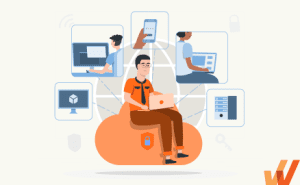
Change doesn’t come easy – especially in enterprise settings. It’s challenging to adopt new ways of doing things, and changes at work are exhausting.
While some resistance to change is normal, too much can prevent digital transformation initiatives from making an impact. Hence, if you’re planning to make significant changes in your organization, it’s crucial to introduce those changes at the right time.
A change readiness assessment can help you determine if your team and organization are prepared for those changes. Let’s go through everything you need to know about change readiness assessments.
What Is a Change Readiness Assessment?
A change readiness assessment measures how prepared an organization or team is to adopt new technologies, processes, or operational methodologies. Gauging readiness helps teams identify barriers or resistance to change so they can make the appropriate adjustments before implementing major transformation initiatives.
Conducting a change readiness assessment ensures any new ways of working are well-received and result in the desired outcome.
Key Components of a Change Readiness Assessment
Several factors contribute to whether or not your organization is ready for change — and, likely, you’ll never feel prepared. It’s nearly impossible to account for every issue that might arise throughout the process, but it’s critical to lay a solid foundation before you begin making any significant changes.
A change readiness assessment measures the following components:
- Organizational culture. How open is your team to change? What is your organization’s risk tolerance? Is your team ready, willing, and able to collaborate to work through change adoption together?
- Leadership commitment. Is your leadership on board with the change strategy? Are leaders able to be change champions throughout the transformation process? Do teams feel confident in leadership’s ability to navigate upcoming changes?
- Stakeholder engagement. Are stakeholders involved in the change process excited about new strategies and processes? Are stakeholders adequately educated on what the change initiative requires and what the goals and desired outcomes of the organizational change are?
- Training needs. What skills gaps exist within your current team that could prevent changes from sticking? Can existing team members be reskilled or upskilled to fill those gaps? What new hires or team additions need to be made to ensure changes are implemented as smoothly as possible? Conduct a training needs assessment to help you identify these gaps and where you need to provide additional training.
- Change management capabilities. Is your team prepared to plan, execute, and oversee a change initiative? Do you have the appropriate processes and tools in place to aid in change management initiatives?
- Risk assessment and mitigation. What are the potential risks of moving forward with the desired change? Are there any steps you can take to minimize or eliminate those risks? What new risks might arise throughout the change process and how will they be handled?
- Performance metrics and success indicators. How will you know if your change initiative has been successful? What are your target metrics, and how do they compare to your baseline numbers? How will progress be tracked and evaluated throughout the change process? Do you require additional analytics tool to track user adoption and engagement?
8 Steps For Conducting a Change Readiness Assessment
Here’s how to conduct a change readiness assessment in eight steps.
1. Identify objectives and scope of upcoming changes
Change for the sake of change is rarely beneficial. Before you begin shifting processes or introducing new tools, identify the intention behind the change initiative. Key questions to answer include:
- What do you hope to accomplish by implementing these changes?
- Why is it important to achieve this goal?
- What types of changes are required to achieve this goal?
- What teams or people will be involved or impacted by the change process?
Having a complete understanding of your change initiative goals makes it easier for you to get key stakeholders involved and determine how you measure success. A set scope can be used to identify process milestones and build a project timeline.
2. Collect data for readiness assessments
Readiness assessments depend on various types of data to determine an organization’s preparedness. Locating and congregating that data early will make the assessment process more accessible.
Data to collect includes:
- Basic data and information about the company, including number of employees, team organizational charts, and history of past changes
- Past change successes and failures
- Current metrics to establish baseline metrics to measure against
- Employee skills, competencies, and openness to training
3. Engage stakeholders and form a change management team
A strong change management team aids the transformation process. Engaging the right stakeholders and getting key leaders involved can boost team morale and keep everyone focused and motivated.
Build a change management team that includes:
Change sponsors to act as an authority and influential voice across the organization
Change managers to oversee planning and implementation
Change agents or champions to drive support amongst teams and peers
Subject matter experts to provide guidance and support
Training and development specialists to identify and fill knowledge and skill gaps
External consultants may also be useful as part of your change management team. They can provide an outside perspective or expertise that isn’t readily available internally.
4. Analyze organizational culture and existing systems
Your organization’s current state will determine how successfully you can implement change. If your team is already overwhelmed or burnt out from past change initiatives, getting them on board will be an uphill battle.
Analyzing your organization’s culture, existing systems, and values can help you strategically determine when and how to introduce change. Look at how proposed changes align with cultural needs and expectations, as well as how much effort it will take to implement compared to the desired payoff.

5. Assess employee skills, knowledge, and attitudes toward change
You can’t do a proper change readiness assessment without getting input from your team of employees. Run surveys, focus groups, interviews, and polls to get perspectives and insights on change plans and ideas.
Work with your team to assess skill levels and identify knowledge gaps. Ask for feedback on training and development programs and look for individuals who are excited about the change. Look for team members interested in undergoing reskilling or upskilling to help fill the necessary gaps.
Enthusiastic team members can become champions of change throughout the transformation process, getting peers involved and excited about what’s ahead.
6. Choose assessment tools
Assessment tools enable you to better collect, analyze, and act upon your change-related data. Tools might include:
Survey and assessment tools to create, distribute, and analyze surveys and questionnaires
Feedback and engagement platforms to collect and analyze employee insights
Change management tools to plan, execute, and monitor steps within the change process
Analytics and business intelligence tools to visualize data and identify trends
Project management platforms to keep teams on track and focused on individual tasks and projects
Collaboration and communication tools to keep team members and stakeholders engaged
7. Identify potential barriers and enablers
Different hurdles or roadblocks can arise throughout your change process. Knowing what to expect can help you anticipate those issues so you can create a plan.
Barriers and enablers will look different across organizations, but common factors that can make or break change success are:
Leadership support and involvement
Attitude towards change
Change education and communication
Employee involvement and engagement
Change expectations and goals
Two critical barriers include:
How will you facilitate the change, support end-users, and drive adoption?
How will you track adoption and measure change engagement?
With a digital adoption platform (DAP) like Whatfix, organizations can accelerate change by supporting employees with in-app guidance and contextual help in the flow of work. Use Whatfix’s no-code editor to create in-app experiences like Tours, Task Lists, Flows, Smart Tips, Field Validations, and more to guide users through contextual tasks and application workflows.

With Self Help, provide on-demand help at critical moments of need. Self Help overlays your digital applications and integrates with your company’s SOPs, knowledge, training decks, and more – providing a searchable wiki for your employees right in their workflows.

Analyze your in-app content engagement, usage, and consumption with Whatfix Guidance Analytics to benchmark and optimize your process completion rates and user journeys. With Whatfix Product Analytics, track any custom event or user action to identify areas of friction and build frictionless processes.
Software clicks better with Whatfix's digital adoption platform
Enable your employees with in-app guidance, self-help support, process changes alerts, pop-ups for department announcements, and field validations to improve data accuracy.
8. Develop an actionable plan
Your change readiness assessment sets your organization up to develop a clear action plan. Using the insights found within the assessment, begin to build timelines and roadmaps that help get your team prepared for change.
Change Readiness Assessment Template
Download a copy of change readiness assessment template to figure out whether your organization is ready for the upcoming change.
✓ Thank you, the template will be sent to your email
Benefits of Conducting a Change Readiness Assessment
Is it worth the extra effort to do a readiness assessment before implementing changes? We think so — here’s why:
- Identifies strengths and areas for improvement. Build a more solid foundation for change with a better understanding of where your organization is strong and where it can improve.
- Enhances stakeholder engagement and support. Lower stakeholder resistance by providing clear goals, expectations, and desired change outcomes.
- Mitigates risk and reduces resistance. Identifies potential risks or points of resistance to properly prepare ahead of time.
- Facilitates efficient resource allocation. Finds the best path to move forward so resources are used efficiently and effectively.
Successful change initiatives depend on easy change management and implementation. Using Whatfix to enable effective change management can reduce friction as much as possible to prevent your team from burning out and ensure they’re always moving forward.
With features like end-user analytics, contextual in-app guidance, and moment-of-need support, you can build stronger change management programs to get better results from your transformation initiatives and plans.
To learn more about Whatfix, schedule a free demo with us today.

Thank you for subscribing!
Thank you for subscribing!



